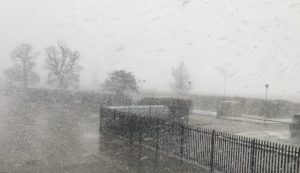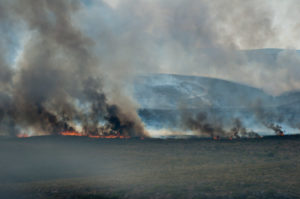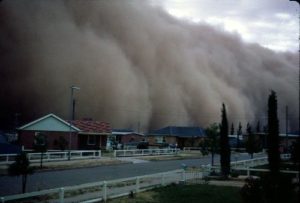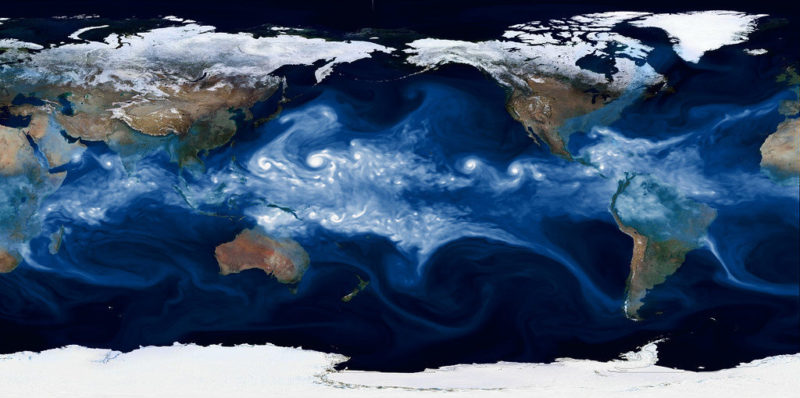Abnormal Weather Might Be The New Normal
By Cara E Scott
Locally, Nationally, Continentally, and Globally, we are all experiencing the harmful effects of climate change on our weather. Extreme weather is becoming more common and is often expected nowadays.
Local

Biggar, in South Lanarkshire, has been experiencing some local effects of climate change in the past week. A car was left stranded in the river after the river banks burst due to flooding last week. Despite the heavy rainfall leading to this, it may all be down to climate change as this has increased the likelihood of flooding in areas that wouldn’t usually experience it. When the rain falls in Scotland, it is more likely to fall in intense periods.
National

Beast from the East (Flickr)
In 2018, the UK experienced an anticyclone (a high-pressure weather system that brings very cold and dry weather) which brought sharp temperature drops and red snow warnings. This cold weather started on the 22nd of February and lasted for 10 days, with temperatures dropping to below -10 Degrees Celsius at some points.
Climate Change had an impact on this extreme weather event as UK winters tend to be warmer than other countries and cities on a similar latitude (the distance north/south of the equator). For example, Moscow’s average temperature for February is a high of -3 Degrees Celsius and a low of -10 Degrees Celsius compared to Glasgow’s average temperature for February being a high of 7 Degrees Celsius and a low of 2 Degrees Celsius. Both of these cities are on similar latitudes.
Continental

Greek Wildfires Kythira (Flickr)
Many Mediterranean countries over the past few years have experienced soaring temperatures during the summer months. A lack of cloud cover in these countries has allowed for high levels of direct sunlight and an increased risk of droughts. This has led to wildfires throughout the continent of Europe.
Some countries that have been affected are Greece, Italy, and Turkey. These wildfires have caused deaths and injuries to the people from the countries affected. Global warming has contributed to these wildfires and if nothing is done to try and reverse the effects of climate change, then countries may be in danger.
Global

Dust Storm (Flickr)
Dust storms are a growing global issue. These storms can affect both local and global climates. The dust from these storms has a positive impact on the Amazon Rainforest as it provides it with essential nutrients. However, it also harms growing crops as it increases soil erosion and reduces photosynthesis (a process that plants use to convert light energy to chemical energy) as the dust blocks the sun’s rays. This also means that it affects the use of solar power. As a result of this, countries may be more likely to burn fossil fuels to produce energy, rather than using renewable sources. This overall will have a negative impact on the climate crisis.
References:
Image 1: “Flooding at Biggar golf course” bygordon.milligan is licensed under CC BY 2.0
Image 2: “The Beast from the East – Explore #260 26th February 2018” by Karen Roe is licensed under CC BY 2.0
Image 3: “Kythira Wildfire” by Grace Trivino is licensed under CC BY-NC-ND 2.0
Image 4: “Dust storm” by expom2uk is licensed under CC BY 2.0
Independent TV. 2021. Watch: Car swept into children’s playpark after severe floods hit Scotland. [online] Available at: <https://www.independent.co.uk/tv/climate/scotland-flooding-car-swept-away-v25a61a68> [Accessed 3 November 2021].
Bbc.co.uk. 2021. Remembering the Beast from the East – BBC Weather Watchers. [online] Available at: <https://www.bbc.co.uk/weatherwatchers/article/47356036/remembering-the-beast-from-the-east/> [Accessed 3 November 2021].
Internet Geography. 2021. Beast from the East – Extreme weather in the UK. [online] Available at: <https://www.internetgeography.net/topics/beast-from-the-east-extreme-weather-in-the-uk/> [Accessed 3 November 2021].
the Guardian. 2021. Wildfires rage in Greece and Italy as EU mounts firefighting operation. [online] Available at: <https://www.theguardian.com/world/2021/aug/09/wildfires-rage-greece-italy-eu-mounts-firefighting-operation-evacuations-destruction-southern-europe> [Accessed 3 November 2021].
World Meteorological Organization. 2021. Sand and Dust Storms. [online] Available at: <https://public.wmo.int/en/our-mandate/focus-areas/environment/SDS> [Accessed 3 November 2021].


